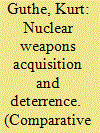|
|
|
Sort Order |
|
|
|
Items / Page
|
|
|
|
|
|
|
| Srl | Item |
| 1 |
ID:
120614


|
|
|
|
|
| Publication |
2013.
|
| Summary/Abstract |
Conventional prompt global strike (CPGS) is the proposed capability to deliver a precision nonnuclear weapon against a target anywhere in the world in less than an hour. Despite years of study and debate, the need for a better understanding of the issues related to this capability remains. Recent political, arms control, and fiscal developments warrant a fresh look at conventional prompt global strike. Analyzed here are potential contributions of CPGS to U.S. national security objectives, weapon-system options for the CPGS role, arms control limits that apply to certain options, and some possible drawbacks of CPGS capabilities. Overall, a number of CPGS options could enhance U.S. and allied security within the existing arms control framework and without creating significant risks.
|
|
|
|
|
|
|
|
|
|
|
|
|
|
|
|
| 2 |
ID:
135839


|
|
|
|
|
| Summary/Abstract |
The Global Nuclear Detection Architecture is a worldwide system for detecting illicit radiological or nuclear (R/N) material and R/N weapons. The technical and nontechnical detection capabilities of the architecture can contribute to the deterrence of nuclear terrorism by increasing the risks and costs of mounting an R/N attack. Risks include the danger of one or more encounters with elements of the architecture, uncertainties about the locations and other characteristics of detection capabilities, discovery upon encounter with detection capabilities, and attack failure upon discovery. Among the costs are the added manpower, money, materiel, time, and operational difficulties entailed by attempts to evade or defeat detection capabilities. The deterrent effect of the detection architecture—part of a broader effort to counter nuclear terrorism—warrants greater attention and emphasis.
|
|
|
|
|
|
|
|
|
|
|
|
|
|
|
|
| 3 |
ID:
108941


|
|
|
|
|
| Publication |
2011.
|
| Summary/Abstract |
The effects of nuclear weapons acquisition on deterrence will depend on the nature of the state, leadership, or even organization that obtains the weapons; the types of actions to be deterred; the purpose and strategy the weapons serve; the consequences for the military situation between the acquiring state and its adversaries; and the ways in which those adversaries respond to the opposing nuclear threat. The implications of nuclear acquisition for deterrence are likely to change over time as nuclear capabilities move from a nascent state and gain, among other qualities, increased size, longer range, more diversity, better survivability, and greater destructive power. Deterrence is not only a matter of who is being deterred, from what action, by whom, for what reason, by what threats, and in what circumstances, but also when in the extended process of acquiring nuclear weapons capabilities a deterrence challenge occurs.
|
|
|
|
|
|
|
|
|
|
|
|
|
|
|
|
|
|
|
|
|